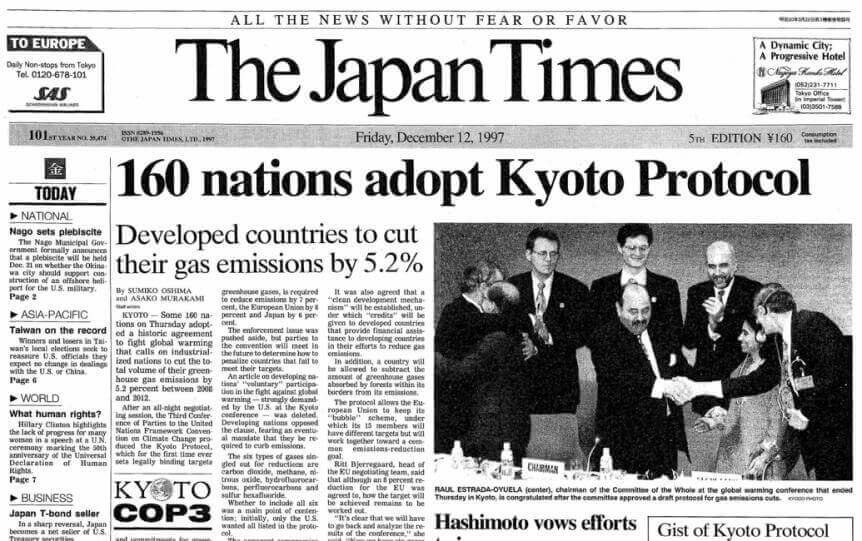In the face of the escalating climate crisis, the world has witnessed a surge in international efforts to combat climate change through collaborative policies and agreements. Two landmark initiatives, the Kyoto Protocol and the Paris Agreement, stand out as cornerstones in the global fight against environmental degradation. This article will delve into these international endeavors, examining their successes and shortcomings while spotlighting additional collaborative initiatives aimed at steering humanity toward a sustainable future.
The Kyoto Protocol: A Pioneering Blueprint
The Kyoto Protocol, adopted in 1997, marked a watershed moment in international cooperation on climate change. Designed as an extension of the United Nations Framework Convention on Climate Change (UNFCCC), the Kyoto Protocol aimed to reduce greenhouse gas (GHG) emissions, chiefly carbon dioxide (CO2), methane (CH4), and nitrous oxide (N2O). Industrialized nations committed to specific emission reduction targets during the commitment period of 2008-2012.

Successes:
The Kyoto Protocol succeeded in raising global awareness about the importance of emission reductions. Countries such as Germany and the United Kingdom surpassed their targets through robust domestic policies, investment in renewable energy, and technological advancements. Germany, in particular, reduced its emissions by 21% below 1990 levels by the end of the commitment period.
Case Study: Germany’s Energiewende
Germany’s Energiewende, or “Energy Transition,” is a prime example of a successful national strategy aligned with international commitments. By heavily investing in renewable energy sources, such as wind and solar power, Germany not only met but exceeded its Kyoto Protocol targets. The country’s commitment to phase out nuclear power and prioritize sustainability in its energy mix set a precedent for other nations.
Failures:
However, the Kyoto Protocol also faced significant challenges, primarily due to the absence of binding targets for emerging economies like China and India. The lack of universal participation limited the Protocol’s overall impact, and some industrialized nations failed to meet their reduction targets.
The Paris Agreement: A New Era of Global Collaboration
Building on the lessons learned from the Kyoto Protocol, the international community came together in 2015 to negotiate the Paris Agreement. Unlike its predecessor, the Paris Agreement adopts a bottom-up approach, allowing each country to determine its nationally determined contributions (NDCs) to combat climate change. The overarching goal is to limit global temperature increases to well below 2 degrees Celsius above pre-industrial levels, with efforts to pursue a more ambitious target of 1.5 degrees Celsius.

Successes:
The Paris Agreement achieved unprecedented global participation, with nearly 190 countries submitting their NDCs. Notably, renewable energy adoption surged, driven by advancements in technology and increased awareness of the economic benefits of a low-carbon transition.
Case Study: China’s Renewable Energy Revolution
China, the world’s largest emitter of CO2, made significant strides in renewable energy adoption, aligning with its commitment under the Paris Agreement. The country invested heavily in solar and wind power, surpassing its 2020 target of 20% renewable energy in its total energy consumption. China’s success highlights the transformative power of international agreements in shaping domestic policies.
Failures:
However, the Paris Agreement faces challenges in implementation and enforcement. Some countries have struggled to translate their ambitious commitments into tangible actions, while others continue to heavily rely on fossil fuels. Additionally, the voluntary nature of NDCs raises concerns about achieving the collective emission reduction needed to meet the agreement’s targets.
Beyond Kyoto and Paris: Ongoing International Efforts
While the Kyoto Protocol and Paris Agreement remain pivotal, other collaborative initiatives contribute to the global climate agenda. The International Solar Alliance (ISA), for instance, aims to facilitate solar energy cooperation among countries, fostering sustainable development and reducing reliance on fossil fuels.

Successes:
India, a founding member of the ISA, has made remarkable progress in solar energy deployment. The country’s commitment to installing 175 gigawatts of renewable energy capacity by 2022, with a substantial focus on solar power, demonstrates the tangible impact of international partnerships.
Case Study: India’s Solar Surge
India’s ambitious solar targets under the ISA have propelled the nation into a leading position in the global solar energy landscape. With innovative policies, such as tax incentives and competitive bidding processes, India has attracted substantial investments in solar projects. The country has successfully harnessed solar energy to electrify remote villages and reduce its dependence on fossil fuels.
Failures:
Despite these efforts, several challenges persist, including financing gaps and policy bottlenecks. Some ISA member countries struggle to overcome economic barriers, hindering the widespread adoption of solar energy and other renewable technologies.
Conclusion:
The intricate dance between global economics and climate change policies reveals a complex landscape of successes and challenges. From the pioneering Kyoto Protocol to the inclusive Paris Agreement and ongoing initiatives like the International Solar Alliance, international collaboration remains essential in addressing the urgent climate crisis. As the world navigates this odyssey, it becomes evident that the success of these policies hinges on sustained commitment, innovative solutions, and a collective determination to forge a sustainable path forward. The journey towards a climate-resilient future requires continuous evolution and learning from both triumphs and setbacks on the global stage.




0 Comments